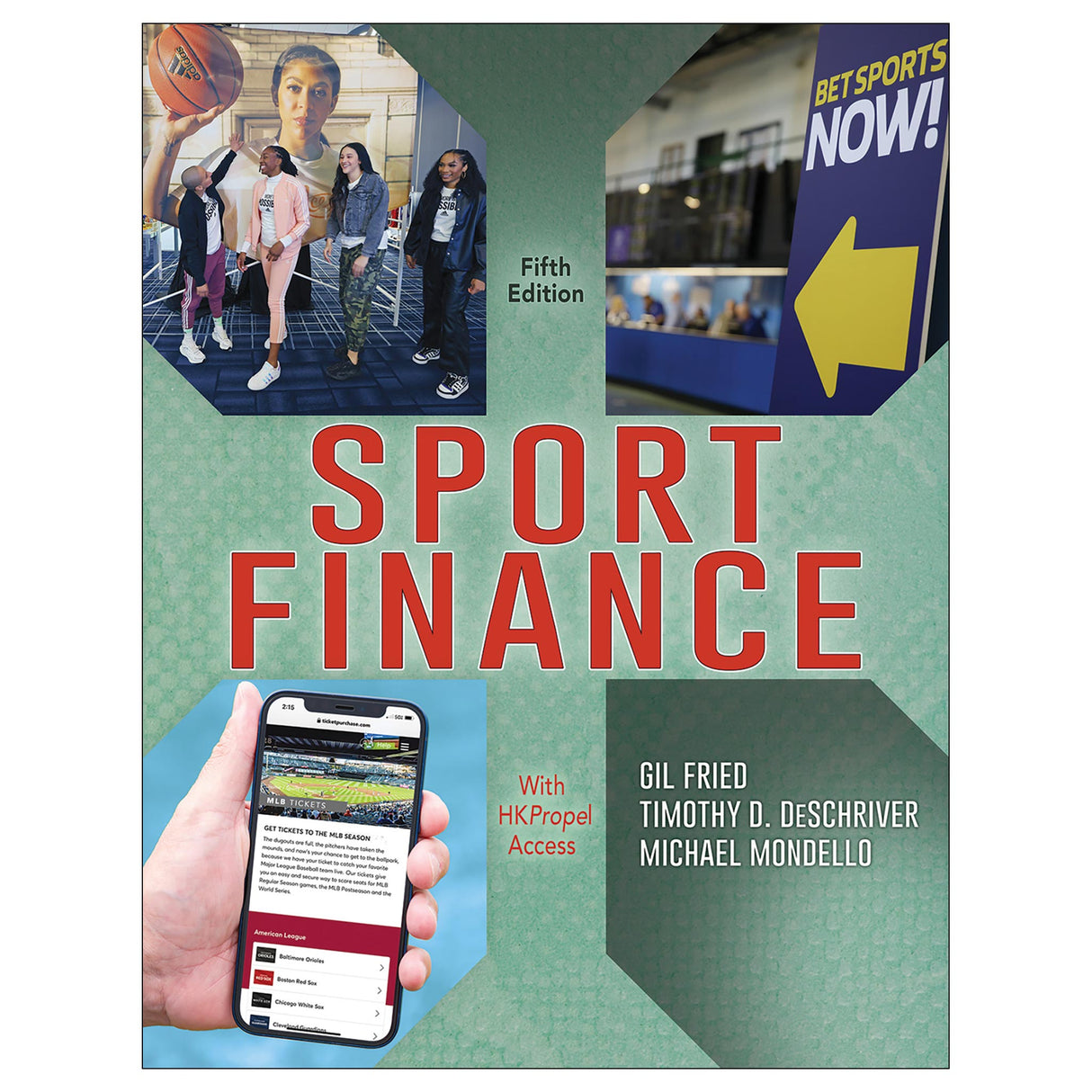Sport Finance 5th Edition Ebook With HKPropel Access
$124.95 CAD

No other textbook connects financial principles with real-world sport finance strategies as effectively as Sport Finance, Fifth Edition With HKPropel Access. Emphasizing a more practical approach, the fifth edition goes beyond the what and how of sport finance and dives deeper into the why—the reasoning behind the principles of sport finance—providing students with an even more comprehensive perspective on what drives the financial success or failure of any sport entity.
The text is organized into five areas, focused on the hard skills tomorrow’s sport financiers must master to perform their role: increasing revenues and decreasing expenses, developing budgets, understanding financial statements and ratios, obtaining funding and managing cash, and building a financial strategy. Each section features an insightful introduction by a renowned industry professional, providing a real-world perspective that’s sure to pique readers’ interest. Chapters addressing revenues and expenses include budgets from the sporting goods industry, intercollegiate athletics, and professional sports.
The sport industry landscape has changed significantly since the previous edition was published, and the fifth edition reflects the new realities affecting today’s sport organizations. Addressed are name, image, and likeness (NIL) rule changes; esports; cryptocurrencies; non-fungible tokens (NFTs); sport gambling; the proliferation of broadcasting rights and the sneaker market; and the impacts of COVID-19 on the sport industry.
The fifth edition’s practical takeaways are especially prominent with the addition of related online resources available to students and assignable by instructors via HKPropel. One highlight is “Two-Dollar Team,” an Excel-based simulation that introduces students to assets and liabilities, revenue and expenses, budgeting, cash management, and borrowing and reveals how these specialties work together in developing financial strategies. Three other assignable class projects involve personal budgeting, expenditures, and a stock market game. Other new features include five brand-new case studies and a profile of a typical health club, “Florida Fitness Club,” in which students are challenged to put their learning to the test by reading and understanding financial statements, setting budgets, and identifying strengths, weaknesses, and growth opportunities for the fictional facility.
Sport Finance provides students with a thorough understanding of the financial and economic aspects of the sport industry. By analyzing sport business entities and structures, financial statements, and funding sources, students will acquire the skills to make more informed and effective financial decisions, better manage the risks, and recognize opportunities in the world of sport.
Note: A code for accessing HKPropel is included with this ebook.
Audience
Upper-undergraduate and graduate students taking sport finance courses in sport management or sport business programs; also a reference for sport business professionals.Part I. Basics of Sport Finance
Industry Spotlight: Hugo C. Chávez Barroso
Chapter 1. Introduction to Sport Finance
Personal Finance Basics
What Is Sport Finance?
Financial Problems Affecting Sport Industry Segments
Financial Solutions
How Sport Finance Affects an Entire Sports Organization or Industry
Conclusion
Chapter 2. Sport Industry Sectors and Segments
Amateur and Participatory Sport
College Sport
Professional Sport
Segments Transcending the Sport Sectors
Conclusion
Chapter 3. Basic Financial Concepts
Revenues and Expenses
Types of Financial Statements
Financial Ratios
Time Value of Money
Economic Versus Financial Analysis
Conclusion
Chapter 4. Assets and Liabilities
Identifying Assets
Identifying Liabilities
Conclusion
Chapter 5. Financial Statements
Types of Financial Statements
Financial Statement Analysis
Annual Reports
Conclusion
Part I Case Study: Responding to Rapid Growth
Part II. Revenue and Expenses
Industry Spotlight: Donna Kirby
Chapter 6. Understanding Revenue
Revenues in the Sport Industry
Revenues in Professional Sport
Revenues in Intercollegiate Athletics
Revenues in the Sporting Goods Industry
Revenue Planning
Revenue Generation
Conclusion
Chapter 7. Understanding Expenses
Expenses in the Sport Industry
Expenses in Professional Sport
Expenses in Intercollegiate Athletics
Expenses in the Sporting Goods Industry
Other Expenses for Sports Organizations
Conclusion
Part II Case Study: Various Approaches to Making a Profit in the Athletic Shoe Industry
Part III. Developing a Budget
Industry Spotlight: Sheena C. Williams-Zmuda
Chapter 8. Budgeting: A Road Map for Sports Organizations
Importance of Financial Planning
Determining Financial Objectives
The Anatomy of a Budget
Budget Types
Pro Forma Budgets and Business Plans
Incorporating the Pro Forma Budget Into the Business Plan
Conclusion
Chapter 9. The Budgeting Process
Collecting the Data
Applying the Data
Building the Budget From the Ground Up
Variance Analysis
Conclusion
Part III Case Study: Minor League Baseball Operational Budget
Part IV. Cash Management
Industry Spotlight: Ken Wajda
Chapter 10. Short-Term Cash Management
Funding Sources
Cash Management Strategies
Open Markets and Other Short-Term Borrowing
Long-Term Borrowing
Funding for Small or Ethnic Minority–Owned Businesses
Conclusion
Chapter 11. Long-Term Cash Management
Stocks
Shareholders’ Rights
Stock Dividends
Sport Stocks
Stock Buybacks
Bonds
Costs of Issuing Bonds
Loan Repayment
Government-Issued Bonds
Long-Term Borrowing
Conclusion
Part IV Case Study: Golden State Warriors Sued Due to a Partnership With FTX Entities
Part V. Financial Statements and Strategic Planning
Industry Spotlight: Ralph Willis
Chapter 12. Financial Planning
Financial Forecasting
Financial Planning Strategies
Capital Spending
Cost of Capital
Projecting Cash Flow
Break-Even Analysis
Managerial Accounting
Conclusion
Chapter 13. Financial Ratios
Liquidity Ratios
Activity Ratios
Financial Leverage Ratios
Profitability Ratios
Determining a Company’s Value
Techniques to Determine the Value of an Investment
Conclusion
Chapter 14. Moving From Strategy to Action
Creation Strategy
Finding Funds and Investors
Keeping an Even Keel
Growth and Expansion
Contraction
Selling a Business
Conclusion
Part V Case Study: Financial Ethics
Appendix A. Mike’s Gym Financial Statements
Appendix B. Under Armour Financial Statements
Appendix C. Time Value of Money
Appendix D. Formulas
Revenue and spending in college sport
The financial growth of esports
All ancillaries are free to adopting instructors through HKPropel.
Instructor guide. Includes a sample syllabus, chapter summaries, assignments, answers to the class discussion topics in the book, suggested essay topics, and tips for presenting the chapter content. A total of 10 case studies are available (5 from the text plus an additional 5), along with study questions for the 5 cases found in the book. Also included are instructional materials for the four class projects featured in the online resources for students.
Test package. Contains 30 questions per chapter in true-false, fill-in-the-blank, essay and short-answer, and multiple-choice formats. Also included are 44 multiple-choice and true-false financial literacy questions to assess students’ current understanding of finance. The files may be downloaded for integration with a learning management system or printed for use as paper-based tests. Instructors may also create their own customized quizzes or tests from the test bank questions to assign to students directly through HKPropel. Multiple-choice and true-false questions are automatically graded, and instructors can review student scores in the platform.
Chapter quizzes. Contains ready-made quizzes (10 questions each) to assess student comprehension of the most important concepts in each chapter. Each quiz may be downloaded or assigned to students directly through HKPropel. The chapter assessments are automatically graded, and instructors can review student scores in the platform.
Presentation package. Features approximately 20 PowerPoint slides per chapter of text, artwork, and tables from the book that can be used for class discussion and presentation. The slides in the presentation package can be used directly within PowerPoint or printed to make handouts for students. Instructors can easily add, modify, and rearrange the order of the slides.
Instructors also receive access to all student materials in HKPropel. For Sport Finance, this includes four class projects that are assignable as trackable activities:
- Two-Dollar Team Game
- Personal Finance Budget
- Personal Finance Expenses
- Stock Market Game
These projects include downloadable files for the students in Word and Excel formats.
Another valuable resource in HKPropel is “Two-Dollar Team,” an Excel-based simulation that introduces students to assets and liabilities, revenue and expenses, budgeting, cash management, and borrowing and reveals how these specialties work together in developing financial strategies. Three other assignable class projects involve personal budgeting, expenditures, and a stock market game.





